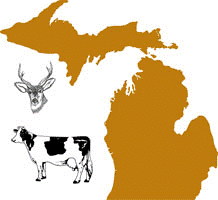Wildlife Disease and Zoonotics

Michigan Bovine Tuberculosis Bibliography and Database
Date of this Version
2002
Abstract
Since 1994, the state of Michigan has recognized a problem with bovine tuberculosis (TB), caused by Mycobacterium bovis, in wild white-tailed deer from a 12-county area in northeastern Lower Michigan. A total of 65,000 free-ranging deer have been tested, and 340 have been found to be positive for M. bovis. The disease has been found in other wildlife species, and, in 1998, in domestic cattle, where to date 13 beef cattle and 2 dairy cattle herds have been diagnosed with bovine TB. Unfortunately, the situation is unique in that there have never been reports of self-sustaining bovine TB in a wild, free-ranging cervid population in North America. Scientists, biologists, epidemiologists, and veterinarians who have studied this situation have concluded that the most logical theory is that high deer densities and the focal concentration caused by baiting (the practice of hunting deer over feed) and feeding are the factors most likely responsible for the establishment of self-sustaining TB in free-ranging Michigan deer. Baiting and feeding have been banned since 1998 in counties where the disease has been found. In addition, the deer herd has been reduced by 50% in the endemic area with the use of unlimited antlerless permits. The measures of apparent TB prevalence have been decreased by half since 1997, providing hopeful preliminary evidence that eradication strategies are succeeding.


Comments
Published in Ann. N.Y. Acad. Sci. 969: 262-268 (2002).